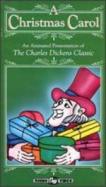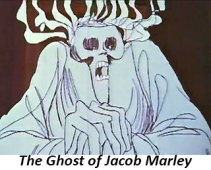 This was the one that started it all for me. This is the first A Christmas Carol I remember watching as a child the first time it was broadcast on U.S. television. The first of two Australian animated versions, this one was made in 1969. It didn’t appear on U. S. television until the 1970 Christmas season (my first viewing) when it was broadcast nationally by one of the major networks. With the great Chuck Jones animated version debuting just a year later, these early ‘70’s animated versions become the first two on my childhood anticipations to watch ACC. The production company that put forth this version did other animated specials I remember: A Connecticut Yankee in King Arthur’s Court which I also remember enjoying. The company and its animation did work for other companies, notably Hanna-Barbera so it offers a familiarity of the period for those of us watching particular cartoon shows of the late 60’s – early ‘70’s. A few years after its initial U.S. broadcast, I pretty much never saw it. That is, I never saw it available on any television channel anymore during the season. If it was shown by local stations, it was never one in the areas I lived in. I was quite happy when I first came across it on VHS in the 80’s (the one pictured above). I never purchased a new one when released on DVD, which I think is now out of print, so I rely on my VHS.
This was the one that started it all for me. This is the first A Christmas Carol I remember watching as a child the first time it was broadcast on U.S. television. The first of two Australian animated versions, this one was made in 1969. It didn’t appear on U. S. television until the 1970 Christmas season (my first viewing) when it was broadcast nationally by one of the major networks. With the great Chuck Jones animated version debuting just a year later, these early ‘70’s animated versions become the first two on my childhood anticipations to watch ACC. The production company that put forth this version did other animated specials I remember: A Connecticut Yankee in King Arthur’s Court which I also remember enjoying. The company and its animation did work for other companies, notably Hanna-Barbera so it offers a familiarity of the period for those of us watching particular cartoon shows of the late 60’s – early ‘70’s. A few years after its initial U.S. broadcast, I pretty much never saw it. That is, I never saw it available on any television channel anymore during the season. If it was shown by local stations, it was never one in the areas I lived in. I was quite happy when I first came across it on VHS in the 80’s (the one pictured above). I never purchased a new one when released on DVD, which I think is now out of print, so I rely on my VHS.
Let’s remember to keep this in context: animated; made for television; 1970; target audience of children. Keeping this in mind is a good way to approach this version. Over the years I’ve read some folks that give this rendering a fairly bad review. For me, it has first and foremost a nostalgic value. Beyond that, however, I think it’s not as bad as some would seem to find it (context!).
1969 / 1970 wasn’t as afraid of giving children a little bit of fright unlike the great fear it is to do so today. There’s a proper setting of London as gloomy and this Jacob Marley is scary. But it’s still targeted to a young audience and doesn’t hide its efforts at child appeal; at times its attempts of kid allure are pretty cookie cutter (that’s not a bad thing).
With a just-gloomy-enough visual setting established, this bypasses the often used exposition of the novella’s opening lines about Marley via voice-over narration (Marley was dead: to begin with. There is no doubt whatever about that.). Instead there is something a little more fresh: we see Scrooge walking past the cemetery and noticing Marley’s grave. Then there is an immediate flashback to Marley’s funeral which established that Marley is definitely dead and how miserly Scrooge was by the cheap funeral.
From here on the pretty standard story is presented but with some eccentricities peculiar to this version. First, there is the odd scene between Scrooge and his nephew, Fred. During their standard exchange in Scrooge’s office, Fred suddenly breaks out in song! At first it appears Fred is just being jovial but the scene turns into an actual musical number when Scrooge sings response lines back at Fred. It’s an odd scene as a musical number in a non-musical version. It’s hard to ignore the odd buck teeth the animators decided to give to Fred; they draw your focus like a large blemish on a face.
 The largest of noticeable oddities is Marley’s ghost. Yesterday’s 1935 version we had an invisible ghost of Marley. Today we get a kid version of full on horror. Marley’s at first transparent figure wears a flowing white robe with a head as a flaming skull while occasionally fully fading in and out of visibility. When Marley informs Scrooge about the chain he is now forging for himself, he becomes invisible with only the chain around him remaining to demonstrate its ponderous attribute and permanence.
The largest of noticeable oddities is Marley’s ghost. Yesterday’s 1935 version we had an invisible ghost of Marley. Today we get a kid version of full on horror. Marley’s at first transparent figure wears a flowing white robe with a head as a flaming skull while occasionally fully fading in and out of visibility. When Marley informs Scrooge about the chain he is now forging for himself, he becomes invisible with only the chain around him remaining to demonstrate its ponderous attribute and permanence.
The Ghost of Christmas Past is an old man who seems something of a cross between a shepherd and Father Time. The past visit here omits Scrooge’s old school and his sister, Fan.
This Ghost of Christmas Present deviates most from portrayals among the traditional retellings of the story which are almost uniform in his depiction. The reason for this is obviously because of Dickens’ description coupled Leech’s original illustrations make it easy to replicate his intended facade. But in this version, he has a slight likeness to the preceding Ghost of Christmas present. With a long white robe and lantern, it is my own observation that he bears some resemblance to the tarot card known as The Hermit.
All in all it’s a watchable version but best for introducing younger folks to ACC. The final proof that this is geared toward children is the ending, itself. The Crachit family stands around a seated Ebenezer Scrooge and sings to him:
- We wish you a Merry Christmas,
- We wish you a Merry Christmas,
- We wish you a Merry Christmas,
- Our dear Mister Scrooge.
Unique
Being a show intended for children, there’s a running gag with Scrooge attempting to sneeze. Throughout the story, he attempts to sneeze but cannot. At one point he inquires to the Ghost of Christmas Present:
SCROOGE: Tell me, Spirit: why is it that this wretched snuff won’t produce a sneeze to clear my head?
GHOST: You’re too mean to give away a good sneeze Ebenezer Scrooge.
After his transformation, Scrooge goes to the Cratchit household (not his nephew’s) on Christmas Day. While sitting with the Cratchit children, he finally manages a good (large) sneeze. This obviously signifies that he is no longer as mean as he was being able to give the sneeze away.
Missing
- Phantom hearse
- Wandering spirits
- Young Scrooge at school flashback
- Fan (Scrooge’s sister)
- Belle as a happy matron
- Ignorance & Want
- Visiting Fred on Christmas
Pingback: A Christmas Carol, Australia #2, 1982 | 25 Days of A Christmas Carol
Pingback: Mister Magoo’s Christmas Carol, 1962 | 25 Days of A Christmas Carol
Pingback: A Christmas Carol, best animated version ever, 1971 | 25 Days of A Christmas Carol